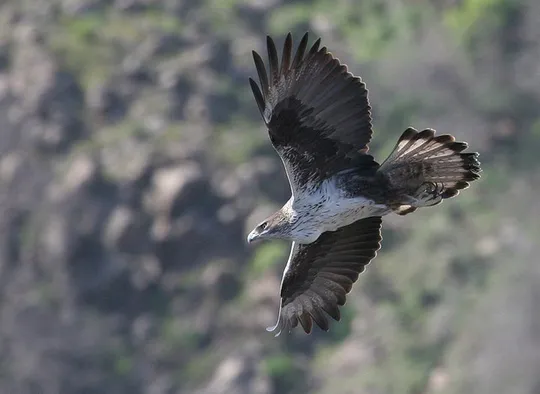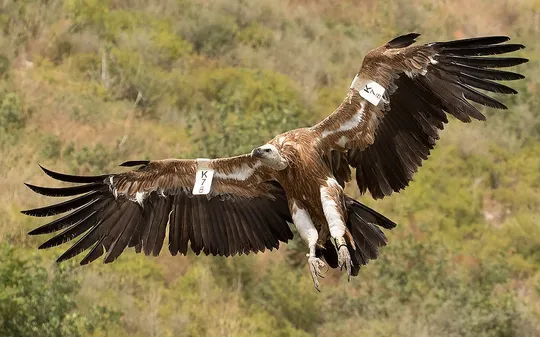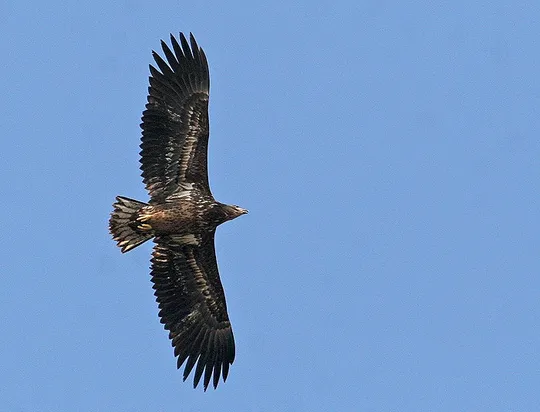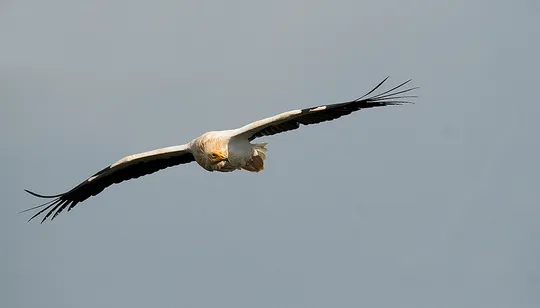Aquila chrysaetos
 Critically Endangered
Critically Endangered
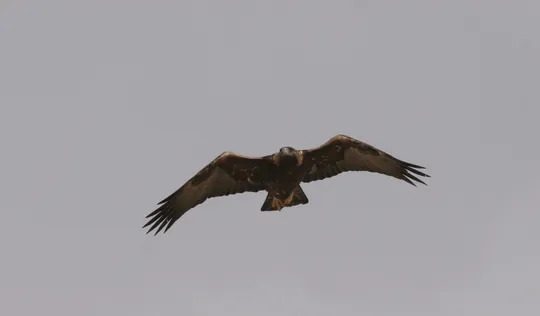
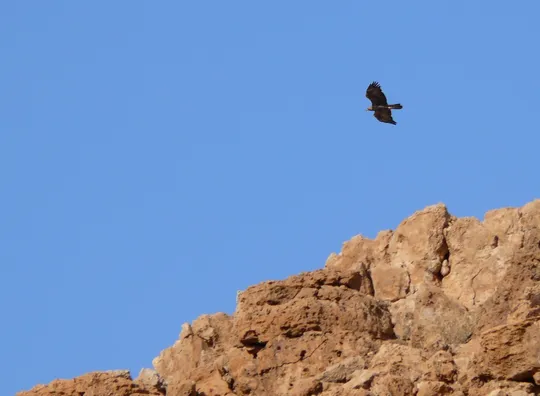
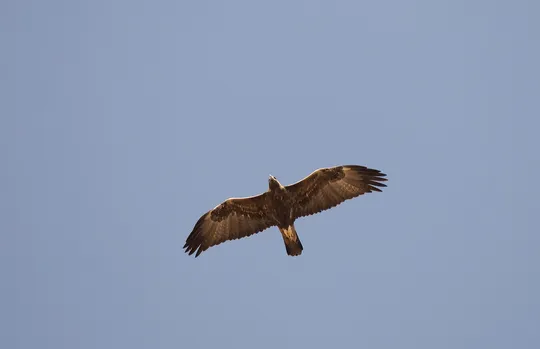

| Habitats | Desert Cliffs |
|---|---|
| Presence In Israel | Resident |
| Breeding In Israel | Breeder |
| Migration Types | Resident |
| Zoographical Zones | Saharo-Arabian, Irano-Turanian |
| Landscape Types | Mountainous, Cliffs |
| Vegetation Densities | Low |
| Nest Locations | Cliffs, Tree |
| Diet Types | Terrestrial Vertebrates |
| Foraging Grounds | Ground |
| Body Sizes | Large (over 1000g) |
| Threat Factors | Nest Harvesting, Electrocution and collision with transmission wires, Human Settlements in Gorges, Hikers and rock climbers, Overgrazing, Pesticide Poisoning, Helicopter and aircraft activity in breeding areas, Hunting and trapping |
The Golden Eagle is a very large and imposing eagle. Its golden nape and raised wings in flight give it a royal appearance (in Arabic, it is termed accordingly the “king of the raptors”). An eagle with an almost cosmopolitan range that feeds on a wide variety of prey that it hunts using diverse methods, from catching tortoises and hurling them on rock surfaces, catching birds in flight, stooping on mammals in vertical dives and rolling ibexes and goats from cliffs. In Israel, it usually nests on cliffs, hunting and foraging near its nest as well as in locales ten or more kilometers away from its nesting cliff.
In Israel, the Golden Eagle now only nests on cliffs in the desert. In the past, it also nested on trees and electrical poles and occupied extensive areas in the Mediterranean and steppe region. Forages over extensive areas that include varied habitats in the desert and desert transition area.
The Golden Eagle population in Israel decreased from about 40 pairs in the 1980s (Bahat 1989) to between 5-8 pairs today. The species has receded from extensive areas where it once bred, such as the Golan slopes, eastern Samaria and the southern Negev. Its rate of decline is estimated at about 90% over three decades. According to the quantitative analysis (PVA), at the current reproductive rate, the probability of extinction for the species is 100% and the average extinction time is 37 years (Mayrose & Hatsofe 2017).
In recent years, there have been extensive efforts to preserve the Golden Eagle population in Israel. The breeding territories are constantly monitored and data are gathered on nesting success and threat factors. In addition, nests with a high risk of being robbed are guarded.
The Golden Eagle is in real and immediate danger of extinction, and without active management and intensive efforts to rehabilitate its population, it could become extinct as a breeder in Israel within a few years.
Regular monitoring and protecting nests from disturbance should be continued. The possibility of supplementary feeding of the nesting pairs to improve breeding success should be investigated. A breeding nucleus should be established in order to release birds into the wild and rehabilitate the Negev population, as it is not clear why it has declined so sharply.
- מירוז, א. והצופה, א. 2014. סיכום סקר קינון עופות דורסים במדבר יהודה. דו"ח רשות הטבע והגנים.
- מירוז, א. והצופה, א. 2017. על מצב אוכלוסיות העיט הניצי והעיט הזהוב בישראל - סיכום נתונים והיערכות לעתיד. דו"ח רשות הטבע והגנים, חטיבת מדע.
- סלע, י. 1975. סקר העופות הדורסים 1970–1975. אוניברסיטת תל-אביב: המכון לחקר שמירת הטבע.
- פז, ע. 1986. עופות. מתוך אלון, ע. (עורך), החי והצומח של ארץ ישראל. כרך 6. הוצאת משרד הביטחון, ישראל.
- פרומקין, ר., מן ש., 1984 .קנון דורסים בחבל המדברי של ישראל 1984-1980. העזניה גליון 11. הוצאת החברה להגנת הטבע.
- Shirihai, H., 1996. The Birds of Israel. Academic Press, London.
- Symes, A. 2013. Species generation lengths. Unpublished, BirdLife International.
- Species page at Birdlife International
Current Occupancy Map
| Data Missing | Sporadic | Limited Sites | Low Density | High Density |
|---|---|---|---|---|
| 0 | 0 | 0 | 0 | 0 |
Distribution maps
The maps presented here provide visual information on the distribution of species in Israel from the past and present, and the changes in occupancy and breeding density during the comparison period. For further reading
Relative Abundance 2010-2020
Breeding density values in the current decade as determined from experts' opinion and observations from databases.
| Data Missing | Sporadic | Limited Sites | Low Density | High Density |
|---|---|---|---|---|
| 8 | 12 | 12 | 21 | 19 |
Relative Abundance 1980-1990
Density values based primarily on the book The Birds of Israel (Shirihai 1996).
| Data Missing | Sporadic | Limited Sites | Low Density | High Density |
|---|---|---|---|---|
| 5 | 14 | 14 | 17 | 22 |
Occupancy 1990-2020
The map shows differences in the species breeding distribution between the 1980's breeding map and the current weighted breeding evaluation. Negative value - species previously bred in the grid and is not presently breeding; positive value - species has not previously bred in the grid and is currently breeding.
| Data Missing | No Change | Occupancy Increase | Occupancy Decrease |
|---|---|---|---|
| 6 | 35 | 1 | 9 |
Change in Relative Abundance 1990-2020
The map shows the changes in the relative abundance of a species in each of the distribution grids between the breeding map of the 1980s and the weighted current breeding evaluation. Negative values - decline in abundance; positive values - increase in abundance; zero - no change in abundance.
| 80 to 100 | 50 | 20 to 30 | No Change | 30- to 20- | 50- | 100- to 80- | Data Missing |
|---|---|---|---|---|---|---|---|
| 0 | 4 | 2 | 22 | 12 | 14 | 11 | 16 |
| Rarity | |
|---|---|
| Vulnerability | |
| Attractiveness | |
| Endemism | |
| Red number | |
| Peripherality | |
| IUCN category | |
| Threat Definition according to the red book |
 Contributed:
Contributed: 